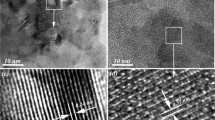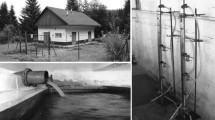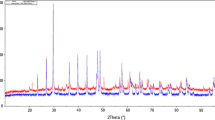Abstract
Potential low-cost sorption materials (mostly industrial by-products) were screened for removal of arsenic from mine effluent water. First, the maximum adsorption capacities were determined in batch tests with various liquid to solid ratios. The highest arsenic sorption capacity, 46 mg As/g of sorption material, was measured for cast iron chips. The most promising materials were also studied in batch tests that assessed the reaction kinetics and in kinetic column tests for their behavior in a filter or reactive barrier application. The column tests revealed the cast iron chips caused clogging in the percolation column when operating with real mine water. A commercial ferric oxi-hydroxide sorption material developed for As removal for drinking water showed good As removal in the column tests. Around 10,000 bed volumes of mine process water containing 2 mg/L of arsenic was treated with this material, and treated water concentrations ranged between 0 and 0.05 mg/L before breakthrough. The measured adsorption capacity for the commercial ferric oxi-hydroxide sorption material was 8.3 mg As/g.
抽象
采用阶梯式方法选择去除矿井废水砷的低成本吸附材料。利用不同固液比的批次试验研究了主要由工业副产品组成的备选吸附材料的最大吸附能力。铸铁碎屑的砷吸附能力最大,达46 mg As/g。同时,利用批次试验研究了最佳备选吸附材料的反应动力学特征,利用动态淋滤试验研究了它们作为过滤材料或屏障材料的行为特征。利用真正的矿井废水进行柱渗透试验时,铸铁碎屑材料存在沉淀引起的堵塞问题。一种用以去除饮用水砷的三价铁氧化-氢氧化物商业吸附材料在柱试验中表现出较好砷去除效果。用这种材料处理了约10 000 bed 体积的含2 mg/L 砷的矿物加工废水,贯穿前砷浓度为0-0.05mg/L。 三价铁氧化-氢氧化物商业吸附材料的砷吸附能力为8.3 mg As/g。
Zusammenfassung
Diese Studie beschreibt einen mehrstufigen Ansatz zur Prüfung potentieller kostengünstiger Sorptionsstoffe für die Abscheidung von Arsen aus Bergbauwässern. Maximale Adsorptionskapazitäten möglicher Stoffe, überwiegend industrieller Nebenprodukte, wurden in Serienversuchen mit unterschiedlichen flüssig/fest-Verhältnissen bestimmt. Die höchste Adsorptionskapazität für Arsen wurde für Gußeisenspäne ermittelt, bei 46 mg As/g des Materials. Die vielversprechendsten Materialien wurden in der Folge in Serienversuchen zur Einschätzung der Reaktionskinetik und in kinetischen Säulenversuchen in Bezug auf ihr Verhalten als Filter oder in reaktiven Barrieren überprüft. Die Säulenversuche ergaben technische Probleme mit den Gußeisenspänen, weil sich bei Verwendung des realen Bergbauwassers durch Präzipitate Blockierungen bildeten. Ein kommerzielles Adsorptionsmaterial zur Reinigung von Trinkwasser, ein Ferri-Oxy-Hydroxyd, ergab in Säulenversuchen gute Arsenfällung. Mit diesem Material wurden ca. 10.000 Säulenfüllungen von Aufbereitungsabwasser einer Konzentration von 2 mg/L Arsen behandelt. Die Konzentration im gereinigten Ablauf lag bei 0 bis 0.05 mg/L, bevor es zum Durchbruch kam. Die Adsorptionskapazität des kommerziellen Ferri-Oxy-Hydroxyds war 8.3 mg As/g.
Resumen
Este estudio describe una aproximación para estudiar diferentes materiales sortivos de bajo costo y su capacidad para remover arsénico de efluentes de mina. Las máximas capacidades de adsorción fueron determinadas para los materiales que fueron fundamentales subproductos industriales, en ensayos batch variando las relaciones líquido-sólido. La máxima capacidad de sorción de arsénico fue obtenida para virutas de hierro fundido: 46 mg As/g del material. Además, también se estudiaron los materiales más promisorios en ensayos en batch para analizar la cinética del proceso y ensayos en columna para su comportamiento en aplicaciones en filtros o en barreras reactivas. Los ensayos en columnas mostraron problemas técnicos con las virutas de hierro, tales como obstrucciones con precipitados en la columna de percolación cuando se operó con agua de mina. Se desarrolló un material comercial de oxo-hidróxido férrico para remover As de agua de consumo mostrando una buena remoción en ensayos en columna. Cerca de 10000 volúmenes de agua de mina conteniendo 2 mg/L de arsénico se trataron con ese material y las concentraciones de agua tratadas tuvieron concentraciones entre 0 y 0,05 mg/L antes de la saturación. La capacidad de adsorción de arsénico determinada para material comercial de oxohidróxido férrico fue 8,3 mg As/g.






Similar content being viewed by others
References
Asta MP, Cama J, Martínez M, Giménez J (2009) Arsenic removal by goethite and jarosite in acidic conditions and its environmental implications. J Hazard Mater 171:965–972
Carlson L, Bigham JM, Schwertmann U, Kyek A, Wagner F (2002) Scavenging of As from acid mine drainage by schwertmannite and ferrihydrite: a comparison with synthetic analogues. Environ Sci Technol 36:1712–1719
De Klerk RJ, Jia Y, Daenzer R, Gomez MA, Demopoulos GP (2012) Continuous circuit coprecipitation of arsenic(V) with ferric iron by lime neutralization: process parameter effects on arsenic removal and precipitate quality. Hydrometallurgy 111–112:65–72
Doušová B, Koloušek D, Kovanda F, Machovič V, Novotná M (2005) Removal of As(V) species from extremely contaminated mining water. Appl Clay Sci 28:31–42
Gräfe M, Beattie DA, Smith E, Skinner WM, Singh B (2008) Copper and arsenate co-sorption at the mineral–water interfaces of goethite and jarosite. J Colloid Interface Sci 322:399–413
Henke K (2009) Arsenic: environmental chemistry, health threats, and waste treatment. Wiley, UK (ISBN 987-0470-027585)
Kaartinen T, Eskola P, Vestola E, Merta E, Mroueh UM (2009) New techniques for waste water treatment of waste treatment centers and landfills. VTT Res Notes 2502 (In Finnish)
Kim J, Davis AP (2003) Stabilization of available arsenic in highly contaminated mine tailings using iron. Environ Sci Technol 37:189–195
King TVV (1995) Environmental considerations of active and abandoned mine lands: lessons from Summitville, Colorado. USGS Bull 2220
Langmuir D, Mahoney J, Rowson J (2006) Solubility products of amorphous ferric arsenate and crystalline scorodite (FeAsO4·2H2O) and their application to arsenic behavior in buried mine tailings. Geochim Cosmochim Acta 70:2942–2956
Lin T, Wu J (2001) Adsorption of arsenite and arsenate within activated alumina grains: equilibrium and kinetics. Water Res 35:2049–2057
Mohan D, Pittman CU Jr (2007) Arsenic removal from water/wastewater using adsorbents—a critical review. J Hazard Mat 142:1–53
Paikaray S, Göttlicher J, Peiffer S (2011) Removal of As(III) from acidic waters using schwertmannite: surface speciation and effect of synthesis pathway. Chem Geol 283:134–142
Paktunc D, Dutrizac J, Gertsman V (2008) Synthesis and phase transformations involving scorodite, ferric arsenate and arsenical ferrihydrite: implications for arsenic mobility. Geochim Cosmochim Acta 72(11):2649–2672
Savage KS, Bird DK, O’Day PA (2005) Arsenic speciation in synthetic jarosite. Chem Geol 215:473–498
Sullivan C, Tyrer M, Cheeseman C, Graham N (2010) Disposal of water treatment wastes containing arsenic—a review. Sci Total Environ 408:1770–1778
Suzuki TM, Bomani JO, Matsunaga H, Yokoyama T (2000) Preparation of porous resin loaded with crystalline hydrous zirconium oxide and its application to the removal of arsenic. React Funct Polym 43:165–172
Tang Y, Wang J, Gao N (2010) Characteristics and model studies for fluoride and arsenic adsorption on goethite. J Environ Sci 22:1689–1694
Thirunavukkarasu OS, Viraraghavan T, Subramanian KS (2003) Arsenic removal from drinking water using iron oxide-coated sand. Water Air Soil Poll 142:95–111
Twidwell LG, Robins RG, Hohn JW (2005) The removal of arsenic from aqueous solution by coprecipitation with iron (III). In: Reddy RG, Ramachandran V (eds) Arsenic metallurgy. TMS Annual Meeting, 13–17 February, San Francisco, CA, USA, pp 3–24
US EPA (2000) Technologies and costs for removal of arsenic from drinking water. EPA 815-R-00-028. http://docplayer.net/6744768-Technologies-and-costs-for-removal-of-arsenic-from-drinking-water.html. Accessed 21 Apr 2017
US EPA (U.S. Environmental Protection Agency) (1998) Final report—arsenic removal demonstration project. Mine waste technology program, Activity III, project 9. http://www.epa.gov/nrmrl/std/mwt/a3/a3p9.pdf. Accessed 20 Nov 13
Wang S, Mulligan CN (2006) Occurrence of arsenic contamination in Canada: sources, behavior and distribution. Sci Total Environ 366:701–721
Zhang F, Itoh H (2005) Iron oxide-loaded slag for arsenic removal from aqueous system. Chemosphere 60:319–325
Zouboulis AI, Katsoyiannis IA (2002) Arsenic removal using iron oxide loaded alginate beads. Ind Eng Chem Res 41:6149–6155
Acknowledgements
This investigation was carried out under the Finnish Green Mining programme by Tekes. The Green Mining project ‘Solution for Arsenic Control in Mining Processes and Extractive Industry (ARSENAL)’ was realized during 2011–2013 as a cooperative project with the Geological Survey of Finland (GTK), Technical Research Centre of Finland (VTT), and Tampere University of Technology (TUT) along with several industrial and international partners. The target of this project was to develop solutions to control and remove As from various As-containing materials and effluents in beneficiation processes and other mining operations. The ARSENAL project concentrated on the following materials and waters: gold ores and concentrates in mineral processes, process and waste waters, and industrial by-products.
Author information
Authors and Affiliations
Corresponding author
Rights and permissions
About this article
Cite this article
Kaartinen, T., Laine-Ylijoki, J., Ahoranta, S. et al. Arsenic Removal from Mine Waters with Sorption Techniques. Mine Water Environ 36, 199–208 (2017). https://doi.org/10.1007/s10230-017-0450-8
Received:
Accepted:
Published:
Issue Date:
DOI: https://doi.org/10.1007/s10230-017-0450-8




